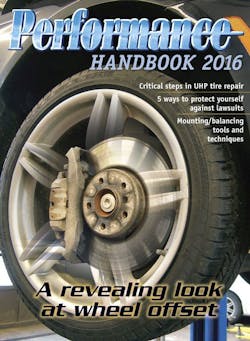In Modern Tire Dealer’s 2016 Performance Handbook, Kevin Rohlwing wrote a dynamic story on how to avoid the lawsuit blues when installing custom tires and wheels. That didn’t mean avoid a lawsuit, however.
“Based on my 20 years as an educator and 10-plus years as an expert witness in court cases, here is my personal opinion on how tire retailers can protect themselves from liability,” he wrote, adding, “but you’re still going to get sued and end up in court.”
Rohlwing, senior vice president of training for the Tire Industry Association, listed these five ways to protect yourself:
1. Follow the 3% Rule.
2. Do not downgrade the speed rating if it is listed on the placard.
3. Make sure the wheel is compatible with the vehicle.
4. Make sure there is a wheel torque program in place.
5. Make sure an operational TPMS is operating after custom wheels are installed.
For specifics on the five ways, check out this link.
However, he actually listed seven ways to protect yourself when installing custom tires and wheels. Here are the other two.
6. Make an effort to set the correct TPMS thresholds when inflation pressures change.
Arguing that the standard of care requires the installer to set the correct TPMS threshold when inflation pressures change as the result of a change in the size of the tire is going to be difficult. First of all, the vehicle manufacturers don’t want to provide too much access and have people start setting thresholds at 1 psi so the TPMS light is never illuminated. Second, in many cases it’s not even possible with or without the new car dealer.
To meet the level that standard of care requires, something has to be readily known or available. In the case of setting TPMS thresholds when inflation pressures change, there are far too many variables, exceptions and limitations for any reasonable person to expect the installer to make a change.
That’s why I say retailers should at least make the effort. Check the TPMS tool to see if it can be changed. Call a local dealer, especially when the inflation pressure change is significant. As far as I’m concerned, an operative TPMS is one that warns the driver when one of the placard tires is 25% below placard pressure. If the placard tire is not installed and as a result the placard pressure is too low for the new tire, then the TPMS is still operative. The process of setting a higher threshold is neither easy nor readily available, so I believe the standard is to make an effort and inform the customer when the TPMS threshold cannot be changed.
7. Make sure everyone is trained.
There are a lot of decisions that must be made before a custom tire and wheel package is sold and installed. Every employee that plays a role in that decision, from the salesperson to the service manager and the technicians, needs to be qualified. In other words, if you are expected to follow the rules, you must know the rules. Of course I’m going to recommend TIA’s training and certification programs because I have a pretty good idea of what they cover. But any and all training is important, so retailers should take advantage of every opportunity that presents itself. Find out what your suppliers offer to make sure the entire staff is trained.
Defending the actions of a tire dealer when a trained and qualified employee followed industry recommendations at every turn is a lot easier to defending one where employees have no training and failed to follow anything.
As Rohlwing wrote at the conclusion of the article, “I recommend you take this to your legal counsel and your insurance company and go over each point so they can advise you on what you should or should not do.”



